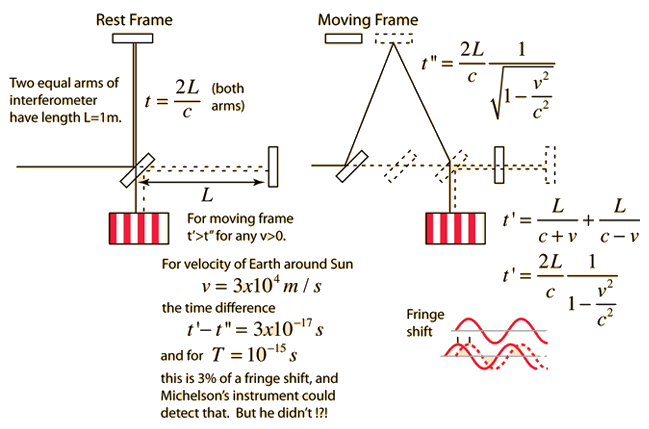A bit of history: Michelson
When Clerk Maxwell wrote to D.P. Todd of the U.S. Nautical Almanac Office in Washington in 1879, he inquired about the possibility of measuring the velocity of the solar system through the ether by observing the eclipses of Jupiter's moons. Roemer had used measurements of the eclipse times to obtain a number for the speed of light. Maxwell concluded that the effects he sought were too small to measure - but that assertion came to the attention of a young naval instructor named A. A. Michelson who had just been transferred to that office. In 1878, Michelson had made an excellent measurement of the speed of light at the age of 25, and he thought the detection of motion through the ether might be measurable.
Michelson proceeded to invent a new instrument with accuracy far exceeding that which had been attained to that date, and that instrument is now universally called the Michelson interferometer. In trying to measure the speed of the Earth through the supposed "ether", you could depend upon one component of that velocity being known - the velocity of the Earth around the sun, about 30 km/s. Using a wavelength of about 600 nm, there should be a shift of about 0.04 fringes as the spectrometer was rotated 360°. Though small, this was well within Michelson's capability. Michelson, and everyone else, was surprised that there was no shift. Michelson's terse description of the experiment: "The interpretation of these results is that there is no displacement of the interference bands. ... The result of the hypothesis of a stationary ether is thus shown to be incorrect." (A. A. Michelson, Am. J. Sci, 122, 120 (1881))
The proponents of an "ether" as a propagating medium for the light were not ready to give up the idea, and proposed that the Earth dragged the ether along with it in its orbit, thus accounting for the negative result of the interferometer experiment. Lord Rayleigh wrote to Michelson, urging him to repeat the experiment with greater accuracy to test these hypotheses. Michelson, with the collaboration of E. W. Morley, constructed a new interferometer with multiple mirrors and a pathlength about 10 times longer. This device should have given a fringe shift of about 0.4, but they observed less than 0.005 fringe (A. A. Michelson and E. W. Morley, Am. J. Sci., 134, 333 (1887)). Although repeated over the next 40 years with ever greater precision and the same negative result, this 1887 experiment is pointed to as one of the experimental foundations of relativity, and earned Michelson the Nobel Prize in 1907.

| Michelson-Morley experiment | Michelson interferometer |
French
Ch 2
| HyperPhysics***** Relativity | R Nave |